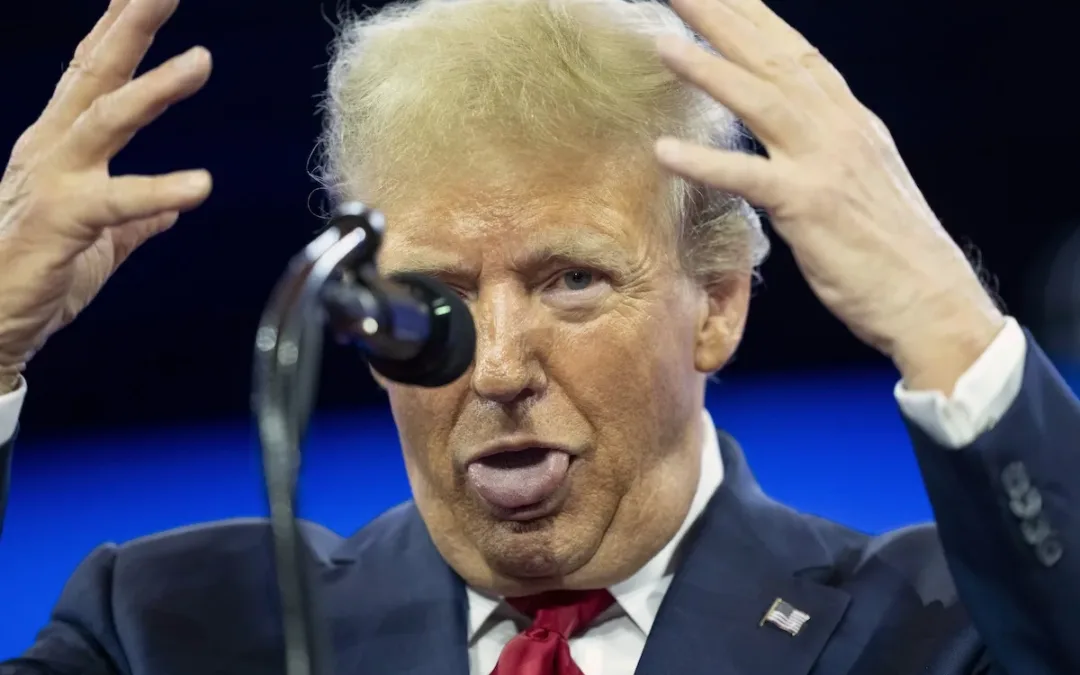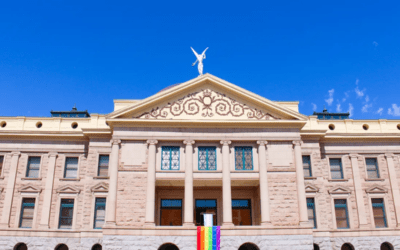
Gregg Sasek, dispersed recreation manager for the Coronado National Forest Santa Catalina Ranger District, demonstrates how ground along the Palisade Trail has been burnt out making it easy for hikers to sink a leg into the soil, on Wednesday, Aug. 12, 2020, near Tucson, Ariz. Various dangers are still being accessed throughout the Coronado National Forest as a result of the Bighorn Fire. (Josh Galemore/Arizona Daily Star via AP, Pool)
Wildfires in Arizona have already burned through about 700,000 acres this year.
Even in an administration known for hiding the truth, the threat of pollution and extreme weather to the US economy can’t be ignored.
The New York Times reports that the Commodities Futures Trading Commission (CFTC) found that “a world wracked by frequent and devastating shocks from climate change cannot sustain the fundamental conditions supporting our financial system.” The CFTC is the federal agency that regulates complex financial products, like futures and derivatives, related to stock and commodity markets.
In other words, the country faces not only destruction from extreme weather events, but also calamity in the financial markets that underpin the US economy. Recent examples of this costly destruction aren’t hard to find, and include the derecho in Iowa, Hurricane Laura in the Gulf, and the ongoing wildfires turning the sky orange in California.
Arizona has experienced its own record wildfires this year, with blazes lasting longer than normal into the summer due to a lackluster monsoon season. As of mid-August,1,600 wildfires in Arizona have burned through about 700,000 acres this year, topping 2018 and 2019’s totals combined.
The Phoenix area has also seen the hottest summer on record, first hitting its hottest month ever in July with an average temperature of 98.9 degrees and then immediately topping that in August with an average 99.1 degrees. As of Aug. 29, Maricopa County had already reported 50 heat-associated deaths with 266 more under investigation. At that time last year, only 38 had been confirmed with 134 under investigation. The county ended up concluding there were 197 heat-associated deaths in 2019, an 8% increase from 2018 and a new record for the area.
RELATED: Here’s What Arizona Would Look Like Under Biden’s Climate Plan
Despite these facts, the CFTC doesn’t expect President Donald Trump’s administration to do anything to stop the climate from warming. Trump has rolled back over 100 regulations that aimed to reduce pollution—for instance, cars can now emit more carbon dioxide and oil and gas refineries can now release more methane gas into the air. And the president’s own reelection bullet points don’t even mention the climate.
Still, Trump called himself as “the great environmentalist” on the campaign trail this week, ironically by reversing his own decision to allow offshore drilling in nearly all US waters. He also tried to paint his Democratic opponent Joe Biden as a president who would give a “free pass” to China, Russia, and India to pollute without restriction, a claim he makes without evidence.
In reality, Biden’s climate plan is detailed and ambitious, and it repeatedly mentions pushing back on China for being the world’s largest source of carbon emissions. In fact, China is still participating in the Paris Agreement, the international deal to reduce pollution that Trump pulled the United States out of in 2019.
Beyond rejoining the Paris Agreement, here are five other major parts of the Biden climate plan that could help prevent continued natural—and economic—disasters in the United States:
- Make the power sector emissions free by 2035. President Barack Obama’s plan to reduce emissions from the power sector called for a 32% reduction by 2030. Biden’s plan goes much further, looking to reduce all emissions from power sources by 2035. That would mean significantly more power generated from solar, wind, and nuclear sources, and far less from coal and natural gas. The remaining coal and natural gas facilities would have to successfully use carbon-capture technology.
- Upgrade US buildings to be energy efficient over the next four years. Biden wants to get 4 million commercial buildings energy efficient by installing and maintaining LED lighting, electric appliances, and advanced heating and cooling systems, all made in America. That work would not only create jobs, but his goal is to return 25% of the money saved from upgrades to state and local governments.
- Require that 40% of clean energy and infrastructure benefits go to disadvantaged communities. Climate change affects economically disadvantaged communities more, as decades of racist housing policies pushed people into hotter neighborhoods or areas more prone to flooding. That has inspired the environmental justice movement, but as one activist told the New York Times, it is usually “an afterthought or it’s not clearly quantified.” Biden’s plan puts environmental justice front and center, and provides hard numbers as goals.
- Set fuel economy standards so that 100% of new sales of cars, SUVs, and pick-ups are zero-emission. Trump gutted an Obama-Biden policy that required automotive companies to increase fuel efficiency by around 5% per year, down to about 1.5% per year. Biden’s new plan goes even further than the 5% goal, and includes a new “cash for clunkers” program to incentivize Americans to turn in old, gas-guzzling vehicles and replace them with electric ones. Biden also wants to add 500,000 new public charging outlets by the end of 2030.
- Invest $400 billion over 10 years to research clean energy. Biden wants to set up a new agency, ARPA-C, with the funding to figure out things like improving lithium battery storage for lower costs, developing refrigerants for air conditioning that don’t pollute, and building smaller and safer nuclear power plants. According to his plan, this investment would be twice what was spent on the Apollo moon program in today’s dollars.
Support Our Cause
Thank you for taking the time to read our work. Before you go, we hope you'll consider supporting our values-driven journalism, which has always strived to make clear what's really at stake for Arizonans and our future.
Since day one, our goal here at The Copper Courier has always been to empower people across the state with fact-based news and information. We believe that when people are armed with knowledge about what's happening in their local, state, and federal governments—including who is working on their behalf and who is actively trying to block efforts aimed at improving the daily lives of Arizona families—they will be inspired to become civically engaged.


BREAKING: AG Kris Mayes sues rental corporations for conspiratorial price-fixing
It looks like, legally speaking, rent really may be “too damn high.” Arizona Attorney General Kris Mayes announced Wednesday a lawsuit against nine...

Op-ed: Trump’s journey from hosting The Apprentice to being the biggest loser
Leading up to the 2016 election, Donald Trump crafted an image of himself as a successful businessman and a winner. But in reality, Trump has a long...

Kari Lake’s plan for the US Senate: ‘The end of democracy’
The world’s most far-right political leaders flocked to National Harbor, Maryland, last week for a conservative conference where attendants idolized...

Flight attendants picket at more than 30 airports in ‘unprecedented’ show of solidarity
Hundreds of flight attendants picketed at Phoenix Sky Harbor Airport last week, calling attention to stagnant wages with low purchasing power, poor...





